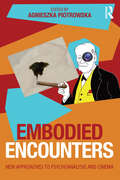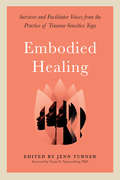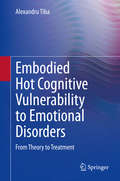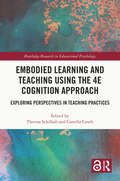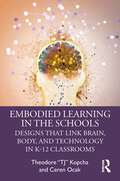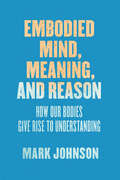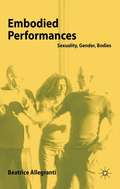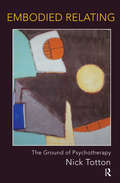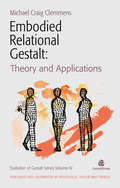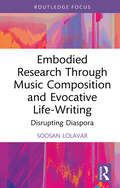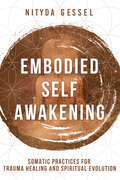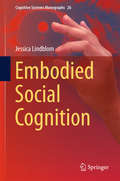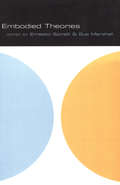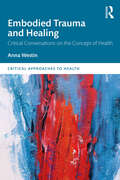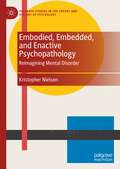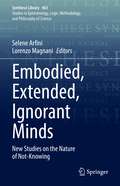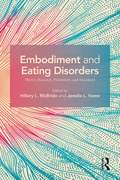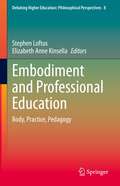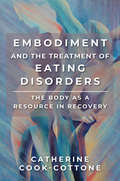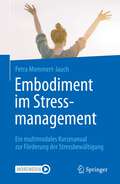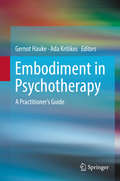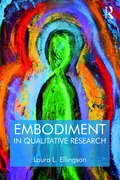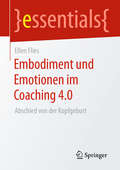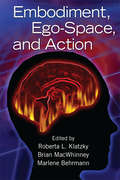- Table View
- List View
Embodied Encounters: New approaches to psychoanalysis and cinema
by Agnieszka PiotrowskaWhat is the role of the unconscious in our visceral approaches to cinema? Embodied Encounters offers a unique collection of essays written by leading thinkers and writers in film studies, with a guiding principle that embodied and material existence can, and perhaps ought to, also allow for the unconscious. The contributors embrace work which has brought ‘the body’ back into film theory and question why psychoanalysis has been excluded from more recent interrogations. The chapters included here engage with Jung and Freud, Lacan and Bion, and Klein and Winnicott in their interrogations of contemporary cinema and the moving image. In three parts the book presents examinations of both classic and contemporary films including Black Swan, Zero Dark Thirty and The Dybbuk: Part 1 – The Desire, the Body and the Unconscious Part 2 – Psychoanalytical Theories and the Cinema Part 3 – Reflections and Destructions, Mirrors and Transgressions Embodied Encounters is an eclectic volume which presents in one book the voices of those who work with different psychoanalytical paradigms. It will be essential reading for psychoanalysts and psychotherapists, scholars and students of film and culture studies and film makers.
Embodied Healing: Survivor and Facilitator Voices from the Practice of Trauma-Sensitive Yoga
by Jenn TurnerFirst-hand essays of embodied healing from the Center for Trauma and Embodiment at Justice Resource Institute: challenges, triumphs, and healing strategies for trauma-sensitive therapists and yoga teachers. All editor proceeds from Embodied Healing will fund direct access to Trauma Center Trauma-Sensitive Yoga (TCTSY).This collection of essays explores the applications of TCTSY--Trauma Center Trauma Sensitive Yoga--as a powerful evidence-based modality to help clients heal in the aftermath of trauma. Written by a range of contributors including yoga facilitators, survivors, and therapists, the first-hand accounts in Healing with Trauma-Sensitive Yoga examine real-life situations and provide guidance on how to act, react, and respond to trauma on the mat. Each essay centers the voices, wisdom, and experiences of survivors and practitioners who work directly with trauma-sensitive embodiment therapies.From navigating issues of touch and consent to avoiding triggers, practitioners and readers will learn how to support survivors of trauma as they reintegrate their bodies and reclaim their lives. Organized into sections based on principles of trauma-sensitive yoga--experiencing the present moment, making choices, taking effective action, and creating rhythms--the 12 essays are for yoga teachers, therapists, survivors, and mental health professionals and trauma healers.
Embodied Hot Cognitive Vulnerability to Emotional Disorders: From Theory to Treatment
by Alexandru TibaThe way we make sense of emotional situations has long been considered a foundation for the construction of our emotional experiences. Sometimes emotional meanings become distorted and so do our emotional experiences become disturbed. In the last decades, an embodied construction of emotional meanings has emerged. In this book, the embodied simulation framework is introduced for distorted emotional and motivational appraisals such as irrational beliefs, focusing on hyper-reactive emotional and motivational neural embodied simulations as core processes of cognitive vulnerability to emotional disorders. By embodying distorted emotional cognition we can extend the traditional views of the development of distorted emotional appraisals beyond learning from stress-sensitization process. Conclusions for the conceptualization of distorted emotional appraisals and treatment implications are discussed. Distorted emotional cognitions such as rigid thinking (I should succeed), awfulizing (It’s awful) and low frustration tolerance (I can’t stand it) are both vulnerabilities to emotional disorders and targets of psychotherapy. In this book, I argue that distorted emotional cognitions which act as proximal vulnerability to emotional disorders are embodied in hyper-reactive neural states involved in dysregulated emotions. Traditionally, excessive negative knowledge has been considered the basis of the cognitive vulnerability to emotional disorders. I suggest that the differences in the affective embodiments of distorted cognition confer its vulnerability status, rather than the differences in dysfunctional knowledge. I propose that negative knowledge and stress-induced brain changes conflate each other in building cognitive vulnerability to disturbed emotion. This model of distorted emotional cognition suggests new integration of learning and medication interventions in psychotherapy. This book is an important contribution to the literature given that a new model for the conceptualization of cognitive vulnerability is presented which extends the way we integrate biological, behavioral, and memory interventions in cognitive restructuring. This work is part of a larger project on embodied clinical cognition.
Embodied Learning and Teaching using the 4E Cognition Approach: Exploring Perspectives in Teaching Practices (Routledge Research in Educational Psychology)
by Theresa Schilhab Camilla GrothThis book operationalises the new field—EmLearning—that integrates embodiment and grounded cognition perspectives with education using the 4E approach as a guiding principle, which suggests that cognition is embodied, embedded, enacted, or extended.Chapters highlight empirical data, providing readers with research-based insight into the theoretical foundations of embodied cognition in learning, illustrated by practical examples. Ultimately, the volume contributes a radical understanding of embodied cognition, demonstrating the importance of the field to the educational system more broadly and suggesting a fundamental change to the way learning, education, and curriculum design are viewed and considered. Based on contemporary scientific findings, the book addresses the educational area with a focus on opening the embodied approach to a wider audience that will circulate the new knowledge and support their educational practices.Written with the purpose of contributing to a broad spectrum of academic educational fields, this book will be of use to postgraduates, researchers, and academics in the fields of higher education, educational psychology, teacher education, and teaching methodology and practice. Teachers and school politicians should also benefit from this volume more broadly.
Embodied Learning in the Schools: Designs That Link Brain, Body, and Technology in K-12 Classrooms
by Theodore “TJ” Kopcha Ceren OcakEmbodied Learning in the Schools explores the relevance of embodied perspectives to instructional designers and education scholars seeking to improve the design, development, and analysis of technology-enhanced learning environments in K-12 settings. Given recent technological advances in touch-based, geolocational, and body integrative devices, there is considerable opportunity to leverage embodied perspectives of cognition to enrich learning in schools today. Grounded in research and theory, this book provides a holistic understanding of embodied cognition’s powerful multidisciplinary applications. Using vivid examples from authentic classrooms, each chapter connects varied theoretical insights to their practical implications for linking brain, body, and technology in learning. Instructional designers, learning scientists, educational technologists, and other scholars and professionals will come away with a comprehensive grasp on the affordances, challenges, frameworks, and embodied designs that can be implemented in real-world contexts across subject areas.
Embodied Mind, Meaning, and Reason: How Our Bodies Give Rise to Understanding
by Mark JohnsonMark Johnson is one of the great thinkers of our time on how the body shapes the mind. This book brings together a selection of essays from the past two decades that build a powerful argument that any scientifically and philosophically satisfactory view of mind and thought must ultimately explain how bodily perception and action give rise to cognition, meaning, language, action, and values. A brief account of Johnson’s own intellectual journey, through which we track some of the most important discoveries in the field over the past forty years, sets the stage. Subsequent chapters set out Johnson’s important role in embodied cognition theory, including his cofounding (with George Lakoff) of conceptual metaphor theory and, later, their theory of bodily structures and processes that underlie all meaning, conceptualization, and reasoning. A detailed account of how meaning arises from our physical engagement with our environments provides the basis for a nondualistic, nonreductive view of mind that he sees as most congruous with the latest cognitive science. A concluding section explores the implications of our embodiment for our understanding of knowledge, reason, and truth. The resulting book will be essential for all philosophers dealing with mind, thought, and language.
Embodied Performances
by Beatrice AllegrantiDrawing from the author's unique interdisciplinary experience Embodied Performances, now available in paperback, responds to the feminist call for advances in conversations across disciplines. Through a pioneering integration of performance, psychotherapy and feminist philosophy it offers an understanding and critique of embodiment and proposes expansive ways of deconstructing (undoing) and re-constituting (re-doing) sexuality and gender and thus more embodied and ethical ways of 'doing' life. Embodied Performances presents innovative ways of 'knowing' and 're-visioning' which evolves the contemporary zeitgeist by: allying digital media with established forms and considering the socially constructed and biological body at the forefront of theory and practice in both the arts and humanities. In addition, it provides practice-based evidence in the form of thirty-six short online film episodes and stills, forming an integral part of the unfolding discussion in each chapter.
Embodied Relating: The Ground of Psychotherapy
by Nick TottonEmbodied Relating is addressed both to body psychotherapists and to verbal therapists, and argues that embodied relating is the soil from which all therapy grows, and that conscious understanding of this makes our work more powerful and accurate.Embodied relating is embedded in our everyday life: we can all 'do' embodied relating, though some do it better than others. Like many other important aspects of life, it generally happens of its own accord, but sometimes benefits from the sort of close examination which tends to happen in therapy. However, psychotherapy has a history of keeping embodiment out of its field of awareness, and of preferring language-based relating to all other kinds - indeed, until quite recently, of downplaying here-and-now relationship altogether. All these things are now changing; and this book is intended to be part of the change.Embodiment and relationship are inseparable, both in human existence and in psychotherapy. If we explore embodiment, we encounter relationship; if we explore relationship, we encounter embodiment.
Embodied Relational Gestalt: Theories and Applications
by Michael ClemmensAn international selection of authors provide a detailed exploration of Gestalt as a somatic and relational practice. Covering many aspects of this relationship, the chapters include discussion of our relationships with nature, the role of Eros, energy in Taoism, affect and methods of practice. Both theoretical and practical application of an embodied relational approach to GT are presented, and many chapters include case studies from the contributors’ own work. The overall view of the book is that our bodies are inextricably embedded and co-creating with the environment, and that we know our body and the world through our embodiment.
Embodied Research Through Music Composition and Evocative Life-Writing: Disrupting Diaspora (ISSN)
by Soosan LolavarEmbodied Research Through Music Composition and Evocative Life-Writing: Disrupting Diaspora examines how attendance to the lived experience of diaspora can impact our scholarly understanding of the term.Through the entanglements between her life and practice as a music composer, British Iranian author Soosan Lolavar weaves together a uniquely embodied approach to academic discussions, enriched by both her personal narrative and music. This book powerfully argues for the unique contribution of ways of knowing that are palpably understood through the body. Lolavar scrutinises the ways that the metaphor of diaspora has left indelible marks on her life and work, exploring these through the narrative presented in this book and publically available recordings of her music. This process allows her to construct new theoretical conceptions of diaspora which bring nuance and detail to a concept used widely across the humanities and social sciences. Disrupting Diaspora presents a map for transdisciplinary work which triangulates artistic practice, theory and evocative life-writing in lively and reflexive ways. In so doing, it contributes to a growing field of embodied scholarly work.This book is primarily written for an academic audience with interests in embodied research methods, diaspora studies, practice-as-research in general and creative research in music composition in particular. It will be suitable for students in the disciplines of music studies, music composition, sociology, communications, creative writing, anthropology and human geography.
Embodied Self Awakening: Somatic Practices for Trauma Healing and Spiritual Evolution
by Nityda GesselAn offering to be with, and to turn toward, the feelings from which we instinctively recoil. We have learned how to suppress our pain and deny its presence, but when we fight against our internal turmoil, glimmers of peace are short-lived. Rejecting our suffering is not a sustainable solution because trauma is held in the body. In this book, Nityda Gessel invites readers on a journey toward lasting freedom, with insights and experiential practices that marry the wisdom of Buddhist psychology, yogic teachings, and Indigenous understanding with somatic psychotherapy and neuroscience. When we heal, our actions and attitudes are not hijacked by our nervous systems as easily. We begin to feel more comfortable in our bodies; more at peace, awake, and free. With Gessel’s invitation, readers will learn to look out into the world, and see more than their own trauma reflected back.
Embodied Selves
by Stella Gonzalez-Arnal Gill Jagger Kathleen LennonThis interdisciplinary collection explores the role the body plays in constituting our sense of self, signalling the interplay between material embodiment, social meaning, and material and social conditions.
Embodied Social Cognition
by Jessica LindblomThis book clarifies the role and relevance of the body in social interaction and cognition from an embodied cognitive science perspective. Theories of embodied cognition have during the last decades offered a radical shift in explanations of the human mind, from traditional computationalism, to emphasizing the way cognition is shaped by the body and its sensorimotor interaction with the surrounding social and material world. This book presents a theoretical framework for the relational nature of embodied social cognition, which is based on an interdisciplinary approach that ranges historically in time and across different disciplines. It includes work in cognitive science, artificial intelligence, phenomenology, ethology, developmental psychology, neuroscience, social psychology, linguistics, communication and gesture studies. The theoretical framework is illustrated by empirical work that provides some detailed observational fieldwork on embodied actions captured in three different episodes of spontaneous social interaction and cognition in situ. Furthermore, the theoretical contributions and implications of the study of embodied social cognition are discussed and summed up. Finally, the issue what it would take for an artificial system to be socially embodied is addressed and discussed, as well as the practical relevance for applications to artificial intelligence (AI) and socially interactive technology.
Embodied Theories (The School of Psychotherapy & Counselling)
by Ernesto Spinelli Sue Marshall`I think this book may well act as both a stimulus for therapists and an important reminder of the vulnerabilities that we all have, but do not always choose to share' - Journal of the Society for Existential Analysis This book sets out to explore the various ways in which a therapist can be a living expression, or embodiment, of his or her chosen theoretical approach. The book consists of expert practitioners articulating their own particular 'embodied theory' answering the questions: how do we live different psychotherapeutic theories? How do they guide or clarify the lives of therapists? What aspects of theory resonate with the ways therapists understand themselves and relate to others? Contributors Michael Jacobs, Windy Dryden, MalcoLm Partlett, Dorothy Rowe, Miles Gorth, Anthony Stevens, John Rowan and Alvin Mahrer.
Embodied Trauma and Healing: Critical Conversations on the Concept of Health (Critical Approaches to Health)
by Anna WestinWhat if philosophy could solve the psychological puzzle of trauma? Embodied Trauma and Healing argues just that, suggesting that one might be needed in order to understand the other. The book demonstrates how the body-mind problem that haunted Descartes was addressed by phenomenologists, whilst also proposing that the human experience is lived subjectively as embodied consciousness. Throughout this book, the author suggests that the phenomenological tools that are used to explore the body can also be an effective way to discuss the physical and mental aspects of embodied trauma. Drawing on the work of Paul Ricœur, Maurice Merleau-Ponty and Emmanuel Lévinas, the book outlines a phenomenological approach to the embodied and relational subject. It offers a reading of embodied trauma that can connect it to wider conversations in psychological underpinnings of trauma through Peter Levine’s somatic research and Bessel van der Kolk’s embodied remembering. Connecting to the analytic tradition, the book suggests that phenomenology can unify both language-based and body-based therapeutic practice. It also presents a compelling discussion that ties the embodied experience of relation in trauma to the wider causal factors of social suffering and relational rupture, intergenerational trauma and the trauma of land, as informed by phenomenology. Embodied Trauma and Healing is essential reading for researchers within the fields of philosophy, psychology and medical humanities for it actively engages with contemporary configurations of trauma theory and recent research developments in healing and mental disorder diagnosis.
Embodied, Embedded, and Enactive Psychopathology: Reimagining Mental Disorder (Palgrave Studies in the Theory and History of Psychology)
by Kristopher NielsenEmbodied, Embedded, and Enactive Psychopathology presents a new way of thinking about mental disorder that is holistic yet critically minded, biologically plausible yet value-inclusive, and scientific yet deeply compassionate. Grounded in an embodied, embedded, and enactive (3e) view of human functioning, this book presents a novel conceptual framework for the study and treatment of mental disorders and explores implications for the tasks of classification, explanation, and treatment. Chapters one to three argue for the central role of conceptualization in the study and treatment of mental disorders. Popular conceptual models are critiqued, including other recent enactive frameworks. Chapters four to seven then present 3e Psychopathology and explore its implications. This includes analysis of both research-based efforts to explain mental disorders, and methods for formulating individual-level explanations in clinical practice. New answers are presented for important questions such as: are mental disorders things we do or get? Are mental disorders defined in nature or are they socially constructed? Are mental disorders the same things across different cultures? And, are mental disorders located in our brains, bodies, or environments? This engaging work offers fresh insights that will appeal to clinicians, researchers, and those with an interest in the philosophy of psychiatry.
Embodied, Extended, Ignorant Minds: New Studies on the Nature of Not-Knowing (Synthese Library #463)
by Lorenzo Magnani Selene ArfiniThis book offers a new and externalist perspective in ignorance studies. Agnotology, the epistemology of ignorance, and, more generally, ignorance studies have grown to cover and explore different phenomena and subjects of research, from known events in history and sociology of science to the investigation of ordinary reasoning and cognitive processing. Nonetheless, although interested scholars have discussed ignorance phenomena and their impact on cognition, most of them have only adopted an internalist perspective to approach this theme. Meanwhile, even though externalist perspectives on cognition flourished in recent literature, authors have paid little attention to the emerging field of ignorance studies. Ignorance has been generally left out from the inquiries on the extension of cognitive states, cognitive processes, and predictive reasoning. Thus, in this volume, we seek to merge the two growing areas of research and to fill this research gap fruitfully. By addressing the uncomfortable themes that pertain to ignorance and related phenomena through an externalist perspective, this book aims to provide much food for thoughts to cognitive scientists and philosophers alike, enriching the current range and reach of both ignorance studies and externalist approaches to cognition.
Embodiment and Eating Disorders: Theory, Research, Prevention and Treatment
by Hillary L. McBride Janelle L. KweeThis is an insightful and essential new volume for academics and professionals interested in the lived experience of those who struggle with disordered eating. Embodiment and Eating Disorders situates the complicated – and increasingly prevalent – topic of disordered eating at the crossroads of many academic disciplines, articulating a notion of embodied selfhood that rejects the separation of mind and body and calls for a feminist, existential, and sociopolitically aware approach to eating disorder treatment. Experts from a variety of backgrounds and specializations examine theories of embodiment, current empirical research, and practical examples and strategies for prevention and treatment.
Embodiment and Professional Education: Body, Practice, Pedagogy (Debating Higher Education: Philosophical Perspectives #8)
by Stephen Loftus Elizabeth Anne KinsellaThis book draws attention to the ways in which an awareness of, and sensitivity to, embodiment can enlighten educational practices. It explores discourses from a range of thinkers, including Merleau-Ponty, Gadamer, Bakhtin, Haraway and Ahmed to name a few. The book argues that attention to embodiment can help us to reimagine the goals of education in ways that fit more coherently with human concerns and that offer the chance to provide education that is more holistic and grounded in our corporeality. Theories of embodiment can be used to modify education at the level of curriculum and at the level of pedagogy. This can help us design educational interventions that fit more naturally with how humans are inclined to learn and thus make educational experiences more meaningful. Attention to embodiment allows us to appreciate the extent to which the body appropriates a professional practice and the extent to which a professional practice appropriates the body of the learner. It shows how greater sensitivity to the body can enliven and enlighten our educational practices, especially in professional education.
Embodiment and the Treatment of Eating Disorders: The Body As A Resource In Recovery
by Catherine Cook-CottoneTools for the clinician to help clients turn their bodies into resources for healing from eating disorders. Embodiment refers to the lived attunement of the inner and outer experience of self. Cognitions are aligned with the sensing and feeling body. Further, in an attuned experience of self, positive embodiment is maintained by internally focused tools, such as self-care practices that support physiological health, emotional well-being, and effective cognitive functioning. For those who suffer from eating disorders, this is not the case; in fact, the opposite is true. Disordered thinking, an unattuned sense of self, and negative cognitions abound. Turning this thinking around is key to client resilience and treatment successes. Catherine Cook-Cottone provides tools for clinicians working with clients to restore their healthy selves and use their bodies as a positive resource for healing and long-term health. The book goes beyond traditional treatments to talk about mindful self-care, mindful eating, yoga, and other practices designed to support self-regulation.
Embodiment im Stressmanagement: Ein multimodales Kursmanual zur Förderung der Stressbewältigung
by Petra Mommert-JauchDer Körper reagiert auf psychische Belastungen und die Psyche reagiert auf den Körper. Genau diese Wechselwirkung zwischen Körper und Psyche wird durch den Begriff Embodiment umschrieben. Was kann der Körper selbst organisieren, um positiv auf die psychische Verfassung zu wirken und welche Bedingungen können ihn darin unterstützen? Diese Fragen werden im Theorieteil des Buches mit der Darstellung von vier Strategien beantwortet. Im Praxisteil wird für die konkrete praktische Umsetzung ein 8-stündiges multimodales Stressmanagement-Konzept vorgestellt, welches als anerkannte Präventivmaßnahme (§20 Abs.2 SGB V) von der Zentralen Prüfstelle für Prävention 2020 zertifiziert wurde. Das Credo des Konzepts lautet: durch ein breitgefächertes Angebot an neuen körperlichen und sozialen Erfahrungen kann das individuell gestaltete Körper-Seele-Konstrukt neue Wege finden, um wieder in Kontakt zueinander und mit der Umwelt zu kommen.Das Buch richtet sich an alle, die im Bereich des Stressmanagements arbeiten, wie klinische Psychologen, Sportmediziner, Physiotherapeuten, Psychotherapeuten, Sportwissenschaftler sowie an dem Thema Interessierten.
Embodiment in Psychotherapy: A Practitioner's Guide
by Gernot Hauke Ada KritikosThis groundbreaking clinical guide explores the theory behind embodiment in psychotherapy, the science that underlies its methods, and how this knowledge can offer greater depth to clinical practice. Experts across the cognitive and behavioral sciences analyze the complex roles of the body in helping create the self and convey agency, and the essential cognitive, emotional, and behavioral processes expressed in movement, gestures, and facial expressions. Diverse techniques are shown bridging gaps between emotional and bodily awareness and verbal and nonverbal communication to reinforce self-regulation, navigate social relationships, and support the therapeutic bond. These practical guidelines demonstrate the versatility of embodiment work in use with individuals, couples, and groups in addressing a wide range of emotional, interpersonal, and somatic concerns. Among the topics covered: · Embodiment as an organizing principle. · Generating body focus: the gate to embodied work and emotional awareness. · Embodiment of social interaction: our place in the world around us. · Resource activation: bringing values into the flesh. · Therapeutic alliance: grounding interaction in space. · The power of embodying values in work place teams. Expanding on while strengthening traditional theory and methods, Embodiment in Psychotherapy brings new directions in healing to researchers, clinicians, and psychotherapists of all schools in psychiatry, counseling, coaching, and social work, as well as psychology students, trainers, managers, and supervisors.
Embodiment in Qualitative Research
by Laura L. EllingsonEmbodiment in Qualitative Research connects critical, interdisciplinary theorizing of embodiment with creative, practical strategies for engaging in embodied qualitative research. Ellingson equips qualitative researchers not only to resist the mind–body split in principle but to infuse their research with the vitality that comes from embracing knowledge production as deeply embedded in sensory experience. Grounded in poststructuralist, posthumanist, and feminist perspectives, this innovative book synthesizes current interdisciplinary theories and research on embodiment; explores research examples from across the social sciences, education, and allied health; and features embodied ethnographic tales and evocative moments from everyday life for reflexive consideration. Each chapter offers flexible starting points for doing embodiment actively throughout every stage of qualitative research. An awareness of, and an active engagement with, issues of embodiment enhances scholars’ ability to produce high quality research and enlarges their capacity as public intellectuals to spark positive social change, particularly within marginalized communities. The strategies offered relate to methodologies from across the entire spectrum: from traditional qualitative methods such as grounded theory, critical/theoretical analysis, and discourse analysis, to arts-based research — including performance, autoethnographic narrative, poetry, and documentary film making. Embodiment in Qualitative Research is designed as a resource book for qualitative researchers who want to explore the latest trends in critical theorizing. The writing style will appeal to researchers who seek a bridge between abstract theorizing and pragmatic strategies for producing outstanding qualitative research, as well as to critical scholars who want to integrate embodied ways of knowing with their theorizing. Graduate (and advanced undergraduate) qualitative methods students and early career researchers, as well as advanced scholars seeking to enrich the scope and texture of their work, will find the text inspiring and engaging.
Embodiment und Emotionen im Coaching 4.0: Abschied von der Kopfgeburt (essentials)
by Ellen FliesDie Zukunft des Coachings ist spannender denn je. Führungskräfte sollen einen agilen und transformativen Führungsstil einsetzen und gefragt sind Führungskräfte, die Empathie, Authentizität und Beziehungsfähigkeit mitbringen. Das neurowissenschaftlich fundierte Coaching-Format SBEAT® (Strategisch-Behavioral-Emotionsaktivierendes-Training) vermittelt auf eindrückliche Weise, wie diese für Führung zentralen Skills entwickelt und trainiert werden können. Der Schlüssel liegt in gelingender Emotionsregulation. Emotionen sind wichtige Ressourcen. Sie energetisieren unser Handeln. Sie determinieren unser Entscheiden und wirken gravierend auf persönliches Wohlergehen und auf die Beziehungsgestaltung ein. Lernen Sie in diesem essential die Arbeitsweise im SBEAT® kennen. Erfahren Sie, wie schnell und nachhaltig die Arbeit mit Embodiment funktioniert.
Embodiment, Ego-Space, and Action (Carnegie Mellon Symposia On Cognition Ser.)
by Brian MacWhinney Roberta L. Klatzky Marlene BehrmannThe majority of research on human perception and action examines sensors and effectors in relative isolation. What is less often considered in these research domains is that humans interact with a perceived world in which they themselves are part of the perceptual representation, as are the positions and actions (potential or ongoing) of other acti
